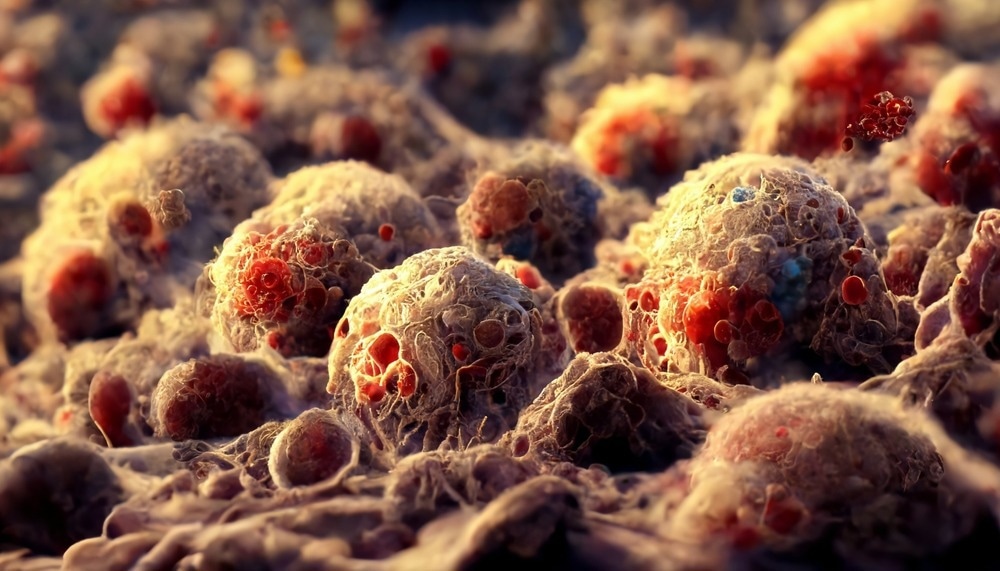In a recent study published in Cancer Cell, researchers performed a molecular analysis of neuroendocrine neoplasm (NEN) patient-derived tumor organoids (PDTOs) and their parental neoplasms.
 Study: Druggable growth dependencies and tumor evolution analysis in patient-derived organoids of neuroendocrine neoplasms from multiple body sites. Image Credit: Aunt Spray/Shutterstock.com
Study: Druggable growth dependencies and tumor evolution analysis in patient-derived organoids of neuroendocrine neoplasms from multiple body sites. Image Credit: Aunt Spray/Shutterstock.com
Background
Neuroendocrine neoplasms (NECs) are malignancies most commonly observed in the lungs and gastro-entero-pancreas. Morphological characteristics and the expression of neuroendocrine markers separate them from adenocarcinomas and squamous cell carcinomas. NECs proliferate in necrotic and apoptotic cells, with small-cell NECs being more prevalent in the lung and large-cell NECs more common in gastroenteropancreatic (GEP) tissues. NETs are highly differentiated, low-grade cancers.
About the study
In the present study, researchers reported case studies in large-cell NEC (LCNEC) and supra-carcinoid patient-derived tumor organoids that emphasize their relevance in developing novel therapeutic regimens and indicators of treatment response.
The researchers created a library of non-endocrine PDTOs obtained from tissues of individuals undergoing biopsy or surgical removal of LCNEC or NET. They also described short-term PDTO cultures from small intestine neuroendocrine tumors (SINETs). They validated the faithfulness of neuroendocrine tumor patient-derived tumor organoids to their parent cancers and demonstrated that they sustain heterogeneity within tumors and processes involved in active evolution using multi-omic and phenotypic analysis.
Using bulk ribonucleic acid sequencing (RNA-seq), they determined whether NEN PDTOs retained the gene expression patterns of their parental malignancies. They found that certain PDTO lines had healthy and malignant cells, whereas others only contained cancerous cells. To analyze the neoplastic purity of patient-derived tumor organoids, they classified them as "mixed" or "high purity."
The team used partial least squares (PLS) analysis, whole genome sequencing (WGS), clonal deconvolution and evolutionary studies, and the TrackSig approach to finding markers that distinguish PDTOs from their parental neoplasms. In addition, they performed dosage titration experiments on five LCNEC PDTOs, including taxane, everolimus, dabrafenib, and trametinib.
The team examined the outgrowth effectiveness of single-cell suspensions obtained from LCNEC and low-grade pulmonary NET 10 (LNET10) PDTOs and PDTOs from other tumor types and healthy tissue-derived organoids in various nicotinamide concentrations.
Further, they examined the demand for growth factors typically employed in organoid culture, such as epidermal growth factor (EGF), fibroblast growth factor-7 (FGF7), and FGF10, to uncover dependencies in NEN PDTOs. They thawed frozen vials of four LNET PDTO lines in an EGF-containing medium and compared their outgrowth over time to the same lines in EGF-free media. They also conducted an EGF dose response outgrowth test. RNA sequencing information from PDTOs, parental neoplasms, and previously reported pulmonary NET datasets were also evaluated.
Results
Researchers created PDTOs from lung NETs and produced PDTOs from LCNEC, an understudied NEC subtype that can occur anywhere in the body. PDTOs preserve parental tumor intra-neoplasm heterogeneity, according to multi-omic molecular studies. A subgroup of pulmonary neuroendocrine tumors was EGF-dependent, indicating a treatment vulnerability in these tumors.
The study revealed the achaete-scute homolog 1 (ASCL1) protein as a possible biomarker for LCNEC response to B cell lymphoma 2 (BCL-2) inhibitor therapy. Drug testing identified therapeutic vulnerabilities and biomarkers, and half of the lung NETs expressed epidermal growth factor receptor (EGFR). T
The researchers observed actionable vulnerabilities in a subgroup of lung NETs, highlighting the efficacy of the PDTO models. The low proliferation index of low-grade NETs is one of their distinctive characteristics. Neuroendocrine marker immunohistochemistry verified their neuroendocrine nature. Successful xenotransplantation into immunocompromised mice through the subcutaneous route validated the tumorigenicity of four LCNEC patient-derived tumor organoid lines.
TMB (tumor mutational burden) was comparable between PDTOs and their parental tumors. TMB was lower for NET than LCNEC, consistent with prior findings. NET PDTOs had fewer single-nucleotide variants (SNVs) with insertions and deletions (indels) in known driver genes than LCNEC PDTOs.
The study also sought to uncover mutations in small-cell lung cancer and the PDTOs that corresponded to them. The team found neoplastic HRAS G13D mutations in all LNET16 samples, including the main lung NET, its corresponding metastasis, and PDTOs derived from the metastasized neoplasm. In addition, they found a somatic-type mutation in multiple endocrine neoplasia, type 1 (MEN1), a commonly altered gene in lung NETs, tumors, and mLNET15-derived PDTOs.
Small cell lung cancer (SCLC) can be categorized based on the expression of lineage transcription factors such as ASCL1, neuronal differentiation 1 (NEUROD1), and POU class 2 homeobox 3 (POU2F3). Preclinical research indicates that tumors from various SCLC molecular groupings have varying treatment vulnerabilities. ASCL1 expression in NENs may be a universal biomarker for BCL2 inhibitor responses.
Based on the findings, the researchers showed a biobank of neuroendocrine PDTOs encompassing diverse human malignancies, including slow-growing and metastatic neoplasms. The biobank included models of low-grade and clinically aggressive lung NETs and low-grade LCNEC NETs. Including low-grade lung neuroendocrine tumor PDTOs in the study collection enhances NEN-related research. The observation of EGF dependency in certain lung neuroendocrine tumor PDTOs has therapeutic relevance since lung NETs secreting membrane EGFR may react to EGFR-targeting treatments.